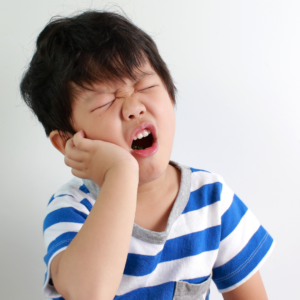 Playing sports is a great way for your kids to get exercise and socialize with their peers. As much fun as a new sport may be for your little one, young athletes are at a higher risk for sports-related injuries. With fall sports in full swing, protecting your child’s teeth while they play sports, not just heavy contact sports, is important. The general cost of fixing a missing tooth can be more expensive than prevention. From head gear to safe play, here are a few ways you can protect your child’s teeth during sports.
Playing sports is a great way for your kids to get exercise and socialize with their peers. As much fun as a new sport may be for your little one, young athletes are at a higher risk for sports-related injuries. With fall sports in full swing, protecting your child’s teeth while they play sports, not just heavy contact sports, is important. The general cost of fixing a missing tooth can be more expensive than prevention. From head gear to safe play, here are a few ways you can protect your child’s teeth during sports.
Head Gear
Injuries on the court or field can be prevented by wearing a helmet. Helmets protect more than just a child’s head, especially one with a face guard. It can prevent your child from breaking or losing a tooth entirely. A face shield can also avoid damage to the delicate bones around the eyes, nose and even jaw. Hockey pucks, basketballs and racquetballs can cause severe facial damage at any age.
Even helmets without the additional front face guard can decrease the physical impact, which would normally cause children to bite down hard enough that they will chip their teeth.
Mouthguards
Children participating in sports such as swimming or soccer may need to wear other forms of facial protection, such as mouth guards. However, unlike football, baseball, and lacrosse, not all sports require a mouth guard, in which case a child would be more prone to accident or injury.
In fact, the National Youth Sports Safety Foundation (NYSSF) reported that a child is 60 times more likely to suffer a sports injury without a mouthguard. Yet, according to American Academy of Pediatric Dentistry, 67% of parents admitted that their children do not wear a mouthguard during organized sports. Last year, the NYSSF forecasted that more than 3 million teeth would be knocked out in youth sporting events. According to the U.S. Centers for Disease Control and Prevention, more than half of the 7 million sports and recreation related injuries that occur each year are sustained by children as young as 5 years old.
While sports equipment can be expensive, mouthguards continue to stay an affordable piece of protective equipment preventing a child from losing or chipping a tooth. Parents can find them at local sports stores where they usually come in one-size fits all. However, only buy those that have the American Dental Association (ADA) seal of acceptance. Mouthguards that don’t have this seal may not meet the dental profession’s standards for protecting teeth and lips. A custom mouth guard is typically recommended by pediatric dentists, which will better protect your child, and are still far less expensive than the alternative: a replacement tooth.
Rules and Risks
Beyond the protection, encourage safe play to avoid potential injury and emphasize good sportsmanship to keep them from any aggressive play that could result in injury. Nothing prevents sports injuries like knowing the rules and the risks that may come along. Teach your child what could happen and scenarios where injuries could occur to keep them playing their best game.
When it comes to the environment, it can make a difference in risks and bumps, bruises, and knocked-out teeth during play. Ultimately, taking good care of your child’s teeth will prevent them from chipping or breaking.
What do I do if a tooth comes out?
First and foremost, keep your child calm and don’t allow them to panic. A parent’s immediate reaction may be to re-implant the tooth, but that can lead to infection, especially if it’s dirty. Hold the tooth by the crown, not the root, and begin to rinse it off. Then, keep it contained inside water, milk, or saliva, or you can store it between the lower lip and gum, until you can get to a dentist. While keeping the tooth moist, control the bleeding in your child’s mouth by using light pressure with a cold compress. Call a dentist immediately and take your child for emergency dental care following the incident.
To avoid any injury, dental experts encourage coaches, parents, and athletes to be proactive on the field and court. Follow these necessary precautions to keep your child safe while they participate in sports to make each of you feel at ease.
Schedule your child’s dental checkup to make sure their smile is on track for a lifetime of oral health.
Source: http://www.aapd.org/

